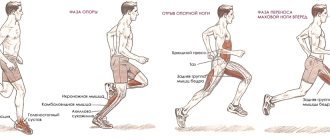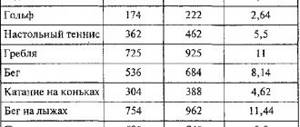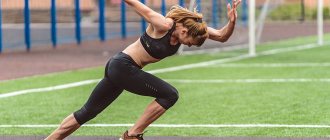Where to run in winter
Running training
To stay fit in winter
11/15/2017 at 08:46 1 2459
Cold weather will soon set in in all corners of our country, and all amateur and professional athletes involved in running will have to decide for themselves the issue of choosing a comfortable place to train in winter.
At first you may feel like your choices are limited and you may experience a slight dip in motivation, but it's not that difficult at all and there are plenty of options for running training in both winter and summer! Let's look at the main ones.
Running in the park
Running on dirt surfaces is the most preferable for beginner runners and is less dangerous because it provides the greatest shock absorption with the surface.
What you need?
find a park near your home (preferably with dirt paths), prepare the right equipment (don’t forget about the principle of layering your clothes), choose the right sneakers
Running shoes for the cold season should not slip (pay attention to sneakers for cross-country running with good tread on the sole), and you should not feel cold in them (this issue can be solved with the help of warm socks and gaiters).. Additional advantages of running in cold weather The park has a pleasant atmosphere, clean air, and the opportunity to find a company of runners like you.
Additional advantages of running in the park are the pleasant atmosphere, clean air, and the opportunity to find a company of fellow runners like you.
If the paths in the park are covered with a small layer of snow, running will be in the nature of strength work, because more effort will be needed to push and lift the hip.
Running outside
This option may be suitable for you if the streets are not yet covered with snow or ice. You should not go for a run if there is a risk of slipping and falling. As for equipment, the recommendations remain the same, but the shoes may be softer and with more cushioning if you run on dry asphalt.
Running in open stadiums
Suitable if you need to train for a certain distance or a series of interval work. At the stadium it is possible to accurately measure the distance and time of its completion. Also, the special stadium coating provides good shock absorption, which reduces the risk of injury.
The following are outdoor stadiums in Moscow where you can practice:
- open sports complex "Iskra". Free entry, Botanical Garden metro station
- open sports complex "Salute Heraklion". Entrance is 150 rubles/hour, there are showers and storage rooms. Metro Water Stadium"
- Open stadium "Energy". Free entry, Aviamotornaya metro station
Running in an athletics arena
The main advantages of running in an athletics arena: comfortable temperature and the presence of tracks with the required surface. The arenas also have showers, strength training equipment or a separate gym.
Below is a list of the main athletics arenas in Moscow:
- Athletics arena "CSKA". Entrance 400 rubles, Airport metro station
- "Bauman Manege". Entrance 180 rubles/hour, metro stations “Baumanskaya”, “Elektrozavodskaya”
- Sports Palace "Moskvich" Entrance 200 RUR/hour, subscription for 8 classes 1000 RUR, Tekstilshchiki metro station
- Cycling track in Krylatskoye. Entrance 240 rubles/hour: upper path; 280 rub/hour: lower path, Molodezhnaya metro station, Krylatskoye metro station
Running on a treadmill
Running on a treadmill is similar to running in natural conditions, and allows you to train in any weather. Selecting different incline levels allows you to add variety to your workout. However, when running on a treadmill, you should pay more attention to the shock-absorbing characteristics of the sneakers (they should provide more shock absorption).
And don't forget that there are many options and alternatives for running in cold weather, the choice is yours! Choose the most suitable place for training, and Decathlon will help you choose the right equipment.
Training program
The lesson plan should be drawn up based on the achievement of which effect is a priority. If the main goal is to get rid of extra pounds, training should be frequent and long-lasting, accompanied by other types of aerobic exercise.
Table: approximate running program for weight loss for a week
| Day of the week | Morning | Evening |
| Monday | Running outside | Jumping rope at home - 20-30 minutes |
| Wednesday | Running outdoors | Abdominal exercises (crunches, leg raises from a lying position) - 3-4 sets of 15-20 repetitions |
| Friday | Run | Work on an exercise bike - 25-35 minutes |
On days off from training, it is recommended not to reduce physical activity, but to engage in sports games, swimming, and spend a lot of time on long walks.
To keep the body in good shape, along with jogging, the training complex should include strength exercises for large muscle groups: back, chest, abdominals.
Table: weekly training complex for tone
| Day of the week | Exercises |
| Monday | Running outdoors |
| Tuesday | Push-ups - 3 sets of 15-20 repetitions (girls are recommended to do push-ups from their knees or from a bench) |
| Wednesday | Day off |
| Thursday | Pull-ups on the horizontal bar - 3 sets of 8-10 repetitions (girls are allowed to do pull-ups on a low bar) |
| Friday | Running outside |
| Saturday | Abdominal exercises - 4-5 sets of 12-15 reps |
| Sunday | Day off |
Table: Example of an 8-week running program for beginners
| A week | Monday | Tuesday | Wednesday | Thursday | Friday | Saturday | Sunday |
| 1 | Cycle 10 times: run 1 minute; walk 2 minutes | Rest | Cycle 10 times: run 1 minute; walk 2 minutes | Rest | Cycle 10 times: run 1 minute; walk 2 minutes | Cycle 10 times: run 1 minute; walk 2 minutes | Rest |
| 2 | Cycle 10 times: run 2 minutes; walk 1 minute | Rest | Cycle 7 times: running 3 minutes; walking 1 minute | Rest | Cycle 6 times: running 4 minutes; walking 1 minute | Cycle 6 times: running 4 minutes; walking 1 minute | Rest |
| 3 | Cycle 5 times: run 5 minutes; walk 1 minute | Rest | Cycle 5 times: run 5 minutes; walk 1 minute | Rest | Cycle 4 times: run 6 minutes; walk 1 minute | Cycle 4 times: run 6 minutes; walk 1 minute | Rest |
| 4 | Cycle 3 times: run 8 minutes; walk 1 minute | Rest | Cycle 3 times: run 9 minutes; walk 1 minute | Rest | Cycle 2 times: run 10 minutes; walk 1 minute; after the cycle run 8 minutes | Cycle 2 times: run 10 minutes; walk 1 minute; after the cycle run 8 minutes | Rest |
| 5 | Cycle 2 times: run 11 minutes; walk 1 minute; after the cycle run for 4 minutes | Rest | Cycle 2 times: run 13 minutes; walk 1 minute; after the cycle run for 2 minutes | Rest | Cycle 2 times: run 14 minutes; walk 1 minute | Run 15 minutes; walk 1 minute; run 14 minutes | Rest |
| 6 | Run 16 minutes; walk 1 minute; run 13 minutes | Rest | Run 17 minutes; walk 1 minute; run 12 minutes | Rest | Run 18 minutes; walk 1 minute; run 11 minutes | Run 19 minutes; walk 1 minute; run 10 minutes | Rest |
| 7 | Run 20 minutes; walk 1 minute; run 9 minutes | Rest | Run 22 minutes; walk 1 minute; run 7 minutes | Rest | Run 24 minutes; walk 1 minute; run 5 minutes | Run 26 minutes; walk 1 minute; run 3 minutes | Rest |
| 8 | Run 27 minutes; walk 1 minute; run 2 minutes | Rest | Run 28 minutes; walk 1 minute; run 1 minute | Rest | Run 29 minutes; walk 1 minute | Run 30 minutes | Rest |
Jogging in the fresh air in winter immediately after strength training at home is strictly prohibited - this can lead to serious hypothermia and cause pneumonia and other serious illnesses.
In addition to its fat-burning and strengthening properties, running outside in winter is an excellent way to get rid of lethargy and weakness of spirit. Regular small victories over yourself will eventually lead to increased self-confidence and will give a new impetus to achieving new heights in various areas of life.
- Author: Author: Alena
Rate this article:
- 5
- 4
- 3
- 2
- 1
(1 vote, average: 5 out of 5)
Share with your friends!
Features of jogging outside in winter
Running in winter is radically different from walking outside at speed in warm weather. And it’s not the jogging technique that changes here, it’s the weather conditions that make adjustments – sub-zero temperatures, cold winds, snow, and so on. But running in winter is an essential factor in the development of physical endurance.
What makes jogging outside in winter difficult:
- Bad weather - severe frost, cold wind, snowdrifts, slippery surfaces, etc.).
- The risk of developing colds, acute respiratory viral infections and flu increases.
- Multi-layered clothing - which in itself complicates the process of weight loss exercises;
- High risk of injury - on slippery surfaces you can easily fall and get injured.
- Decreased endorphin (the hormone of joy) in the body in winter.
Another factor that complicates running in the morning outside in winter is laziness. It’s clear that when the temperature on the thermometer drops below 10°C, you don’t even want to go outside, let alone run. And here, no motivation or benefit will help, only willpower.
The benefits and harms of running for your body
If you decide to start running in winter, think carefully, because the consequences can be very different.
You need to consider all aspects of training in order to ultimately achieve good results and not regret your decision.
But first, let's learn everything about running outside in winter, study its benefits and harms.
Health effects
If you decide to go for a run, and the temperature outside has not yet reached -15, there is no strong wind at all, you will not find better conditions.
This is how you can achieve positive health results, as well as have a beneficial effect on muscles, all internal organs and immunity.
In spite of everything, the body will be hardened, in the future temperature changes will not make you tremble, and one cannot ignore the fact that in such conditions the lungs and heart are well developed.
Today, many are trying to spend the winter at home and go out less, but this is completely wrong.
By doing just one run, you get the necessary supply of oxygen that you won’t find within four walls.
One of the main conditions for a comfortable winter jogging is the right clothes.
Clean air is very important for the normal functioning of the whole body, which is why it is the main advantage of running in winter.
As for the negative, there is very little of it.
There are two basic rules that must be followed so that when jogging in winter you do not cause enormous harm to your body.
It is very important to choose the right clothes. Otherwise, you can get hypothermia and develop a huge list of diseases
Below you will find tips on how to avoid this effect.
If the temperature is very low, you risk burning your lungs. Therefore, if running in winter has become a discovery for you, you should not immediately rush headlong into the pool, follow all the instructions, and be careful. In the future, a scarf on your face or a special protective mask will help you cope with the cold air.
Remember to have three layers of clothing
Effect on the body and muscles in general
Running outside in winter is a huge benefit for any person’s body, but it must be approached with caution and prudence.
Its main benefits for muscles are:
- In winter, the paths are slippery, so many more muscles are involved in the work than when jogging on regular asphalt. The muscles of the thighs, buttocks, calf and ankle joint begin to work much better, thus becoming stronger.
- If you run in the snow, your thigh rises much higher, and at this time its front surface gets a good workout. In the summer, you have to force yourself to lift it for the same effect.
When it comes to the damage winter running can cause, you need to be very careful.
Before you start training, warm up your muscles well, otherwise they may simply tear when you start the cross-country.
Especially if there are obstacles in your way, it can be very easy to twist your ankle.
Don't neglect your warm-up, or at least run on a flat surface for the first ten minutes.
Warm-up is especially important in winter
Effect on excess weight
The main and significant advantage of exercising in winter over summer is that all muscles tense up greatly, thus receiving a huge load, regardless of whether you want it or not.
This is exactly what you need to lose extra pounds.
With the help of running, all fat is converted into energy, so we can conclude that in winter the chance of losing weight increases by approximately 30%.
It can be considered a universal remedy to say goodbye to excess weight.
Running outside in winter can also be harmful. The weather is quite changeable; it is not always easy to predict what it will be like tomorrow or even in the next half hour.
And to lose weight, you need constant, regular exercise.
Therefore, those runs that you manage to do will not be able to bring the expected result, because you will often need to sit out due to weather conditions.
You also need to remember that during the winter, our body voluntarily accumulates fat - this is the best heat insulator, so the body of any person is reluctant to part with its excess.
The chances of losing weight through winter jogging are 30% higher than those in the warm season
If you want to improve your performance in both middle and long distance running, learn proper breathing, technique, warm-up, and also focus on proper strength work.
Videos on the dangers and benefits of winter running can be a great help in this regard.
Temperature
Comfortable temperature for running in winter
With the right equipment and preparation, you can run in winter in almost any weather. But if the temperature drops below -20, then going for a run is still not advisable. And in strong winds it will also be uncomfortable to exercise.
Is it worth running in severe frost?
Even for a trained athlete, running at temperatures below -20 is highly undesirable. In this weather, jogging can only get you pneumonia.
Running in the snow
Running during snowfall is completely possible, especially if your face is well protected. The only difficulty may be with the road. If there are no specially cleared paths, then it will be difficult to run, since there will be a continuous mess of snow under your feet.
Running during a snowstorm
Heavy snowfall may not affect your run, but strong wind and snow will not create the best conditions. It will be very difficult to run in such weather. Breathing becomes faster, and if the wind is in your face, you will hardly be able to breathe often. Therefore, in a strong snowstorm it is better to stay home.
Duration of training
Running in winter, as at any time, should take at least 30 minutes, and ideally all 40. But if winter is not the first season for a runner, then the duration will depend on the level of training and the athlete’s goals.
Run in winter. And I have five reasons for this
It got cold outside. Now fewer and fewer people go jogging, explaining their refusal with a host of arguments. Today we will figure out what can really justify an athlete, and what are just prejudices and myths about running in winter. If you invite your friend for a winter jog, but he refuses, quoting Igor Nikolaev’s famous song “Five Reasons,” read on and choose suitable counterarguments!
"I will freeze"
This is perhaps the most common reason to skip an outdoor workout. But we don’t sit within four walls all winter, do we? One way or another, we go outside the warm room and freeze if we don’t dress warmly enough. Or, conversely, we overheat, then quickly cool down and get sick. The same thing happens if running equipment is chosen incorrectly.
The main rule when choosing a sports uniform is to dress so that the first 5-10 minutes are a little cool. During the workout itself, the body will begin to accumulate energy and warm itself.
"I'll catch a cold"
This point is a continuation of the previous one, so let’s look at our equipment in detail. We choose high-quality and always sportswear: it is better to buy a long-sleeve fleece than a cotton or wool jacket, which will get wet after a couple of kilometers and cause a cold.
For a winter run, you need to put on many layers: the bottom layer, which is moisture-wicking, is thermal underwear, the second layer should be warm - this could be, for example, long sleeves and pants, and on top - a jacket that will protect from wind and precipitation.
Another rule: the upper part of the body should be dressed warmer than the lower part, because the legs work more actively than the body and warm up faster. Don't forget about the hat, neck buff, gloves and socks.
Hats and gloves for winter running
Gloves or mittens are chosen from natural material. Here grandmother's or mother's care will come in very handy. It is preferable to choose an option with a single section for fingers. This accessory retains heat for a long time.
Hats are also different. There is a balaclava that can easily protect your entire face from biting frosts. Choose a knitted hat that covers your neck and ears. It will be very useful to purchase special glasses. Don't forget that it snows in winter, and this is not very convenient when snowflakes cover your eyes.
Running in winter how to dress
Sportswear for running in winter should wick away moisture well from the surface of the body, retain heat, and at the same time not be bulky or restrict movement. And we will start not with a jacket or pants, but with less noticeable things.
An important part of equipment is socks, although many do not pay enough attention to them. Knitted wool socks are a bad option, even though they are considered the best for winter. You should also not wear several socks, one pair on top of another. One “correct” pair is enough. It is better to buy socks for running in winter, half-wool, with a thermal effect. These socks retain heat well, have no seams, are high enough to protect the shin from the cold, and have a special ribbed sole for better contact with the shoe.
We rise higher. Whatever clothes you choose for winter jogging, follow the “three layers” principle:
First layer
– retains heat and removes moisture from the surface of the skin: .
Second layer
– heat insulating. Its main task is to retain the heat generated by the body. An excellent option is .
Third
– top, windproof layer. Its main task is to protect from cold wind. Windproof jacket.
Thermal underwear for running in winter
Thermal underwear fits tightly to the body and is worn under a tracksuit. Thanks to the properties of the materials used and the special weaving of the fibers, this type of clothing allows the skin to breathe, maintains a comfortable body temperature, and pushes out excess moisture that is released when running in winter. Removing excess moisture is necessary to maintain the thermal insulation properties of the material and for a comfortable feeling when playing sports. Thermal underwear is made from synthetic materials (polyester, elastane, acrylic, polyamide). And due to the addition of natural ingredients (wool, cotton), it becomes softer to the touch and more comfortable.
Do not run in cotton underwear, as cotton absorbs moisture well and will quickly lose its insulating properties and block air circulation.
Sports suit
The second layer of clothing, depending on weather conditions, can be used either as a complete set (top and bottom), or just the top. Fleece clothing fits perfectly. Fleece is very soft and pleasant to the touch, light and elastic, “breathes” well and does not let heat out. In addition, it does not require special care and does not wear out for a long time. Fleece can have a different weave structure, density and thickness, and be single- or double-layer.
Pants and jacket (windbreaker)
The top layer of clothing is a jacket and pants made of material with good windproof and water-repellent properties. must be windproof and protected from rain and snow.
Gloves and hat
Woolen, knitted or other gloves are suitable for hands. It is advisable that there are no compartments for fingers - it will be warmer.
Place a knitted hat on your head, possibly with a fleece lining. A scarf can be replaced by a special headdress. Balaclava is worn by skiers and snowboarders. It covers the entire head, leaving only slits for the eyes and sometimes the mouth. It's also convenient to rob a bank =) A balaclava is needed for running in winter, if the temperature is very low or there is a strong wind outside. Also, if there is a headwind, take safety glasses.
When choosing how to dress for running in winter, expect temperatures to be 10 degrees higher than outside. When running, the body generates a lot of heat and, if you overdo it, you can get overheated and excessive sweating.
Winter, with its frosts and snow, is not an obstacle to playing sports outside if you are well prepared for these activities. This article will help you overcome the first stage of preparation - information. Armed with the above tips and recommendations, you can move on to the next steps: acquiring the necessary equipment and morale. Good luck!
What to run in in the fall
Mikhail Safronov
This is one of those questions that may not have a specific answer, but that new runners ask quite often.
Running equipment in the fall is selected based on weather conditions, in particular air temperature. In most cases, autumn running is not much different from summer running. And summer temperatures can sometimes be lower than autumn ones. Therefore, dividing running clothing by season is incorrect in itself: you need to look solely at the thermometer and the presence of precipitation.
Shorts and tights
In hot weather, such questions do not arise - even in shorts you are drenched in sweat. As the temperature drops, your feet may begin to get a little cold and natural questions arise about how to insulate them, whether it is necessary at all and at what temperature.
We once wrote that the optimal transition limit from shorts to pants is 12 degrees Celsius. It is possible to expose the knee joints in the cold without consequences for their health, but this is only provided that they are not subjected to systematic cyclic load. That is, this is not our case.
The best clothing option for the lower body during the average fall is, of course, tights. Regular rainfall coupled with winds can quickly make the air damp and cold. If your running pace is low, then training in shorts may no longer be comfortable.
For those who for some reason do not accept tight clothing (even though it is ideal for running), we can advise you to look for running pants (for example, Kalenji at Decathlon). But you need to understand that trousers provide less comfort for the legs than tights, as well as worse moisture management.
It’s better to still have tights in your wardrobe and, getting rid of stereotypes, train in any cold weather with them, because that’s what they’re made for. In addition, in extreme winter frosts they can be worn under trousers as thermal underwear.
Raincoats and windbreakers
Autumn is the rainy season (at least in St. Petersburg), so you need to prepare for water procedures. A windbreaker jacket or raincoats made of membrane fabrics immediately come to mind. But, as we know, the membrane can only work well in colder temperatures at an easy pace.
In any case, of course, membrane waterproof jackets are always better than conventional fabrics (and even more so, rubberized raincoats), but really good options are not cheap.
The main requirement in the fall is windproof outerwear, so you can buy an ultra-light and inexpensive jacket with ventilation on the sides or back to wick away sweat. The company in this case is absolutely not important, so don’t overpay and take the cheapest one.
Sneakers
In the fall, trail running in northern latitudes is dominated by running shoes with more aggressive soles due to the many wet and muddy areas on forest trails. City sneakers for running on asphalt remain the same as in the summer. Moreover, they continue to serve in winter; no special shoes are required, as long as the soles maintain good grip on the surface.
If you are in danger of catching a cold and getting sick when your feet get wet from running through puddles, then we can recommend wearing thermal socks or thin woolen socks, which can lose only 20% of their heat-protective properties when wet. But most likely, such solutions are more suitable for winter, otherwise your feet will be wet simply from sweat.
We looked at the nuances of wet weather in our related post on running in the rain.
Hats
The head must be protected from the cold. In late autumn it can blow out quite seriously, and especially when it is wet.
You can initially look for a jacket with a hood - this is a great option for rain, but often your head in a hood gets wet much faster than when running in a downpour.
Regular caps and light hats with some kind of windstopper work better and they are much more convenient because they are independent elements.
Gloves
When the air temperature approaches zero, your hands begin to freeze when running due to constant cooling by wind currents. Any gloves that are comfortable for you will do. But there are also special ones, running ones. Of course, they are lighter, more comfortable and not blown through.
Other equipment
Other clothes for running in the fall include a good moisture-wicking T-shirt, running sweaters of all modifications and a buff - a sports tubular scarf, the options of which are also very diverse: from thin and weightless to winter, made of fleece.
Winter running shoes
To choose the right shoes, immediately give up the sneakers you used to train in in the summer. Visit a sports store
What to pay attention to
- Size. Sneakers should be 1.5 sizes larger than your usual size. The reserve will allow you to accumulate warm air, so your feet will not freeze when running.
- Sole. The strong rubber sole of the foot, with studded elements, guarantees a high-quality and comfortable run.
- Laces or Velcro are your choice. There is an option for warm winter sports sneakers. Only if it is a quality product from well-known brands, for example “ASICS”. Prices for winter products start at 5,990 rubles.
You can get harm when running outside in winter only in the following cases:
- You didn't choose the right clothes. Will lead to hypothermia. We have considered this.
- Pulled muscles or ligaments. This is typical for beginners without warming up. This point was taken into account.
- Regular jogging in winter. This was the point of the story. Only on a regular basis will we be able to lose excess fat and keep our muscles in winter tone.
You see how important and necessary running is in winter. Even doctors recommend regular active movement on the street for older people, but God himself told us young people to do so. I hope you liked the article, I look forward to your comments. Share with friends and subscribe to blog updates. Happy New Year of the Red Rooster! But he runs well. Keep training, exercising and living a healthy lifestyle. Best regards, Sergei.
What to pay attention to after a run?
The knees suffer most often when running. The knee itself, under the kneecap, and around it can also hurt. To relieve pain, it is recommended to apply ice. Wrap it in a towel and keep it there for 20 minutes several times a day. You can also stretch a little: to do this, you need to lie on your side so that your sore leg is on top. Raise it, hold it in this position for 45 seconds and lower it.
There is no need to run until the pain goes away. If the pain does not go away for several days or the knee is swollen, contact a therapist or traumatologist.











